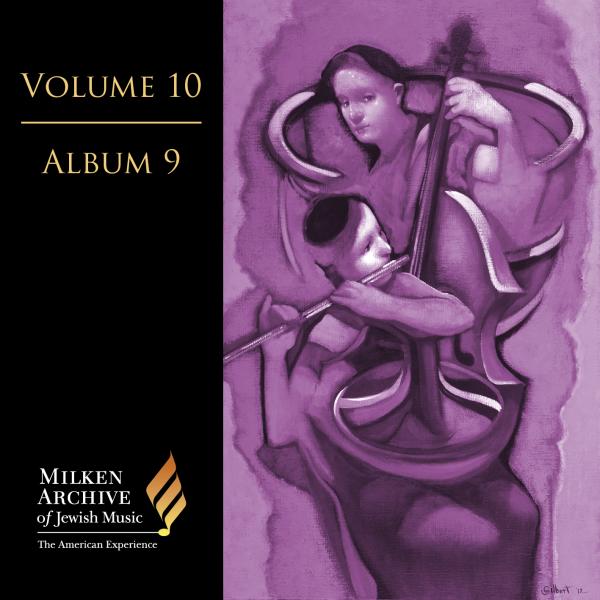Tracks
Liner Notes
In 1997 the Jewish Theological Seminary of America and the Hebrew Union College–Jewish Institute of Religion jointly sponsored a five-day international academic conference and music festival—titled “Voice of Ashkenaz”—in New York celebrating the musical legacy of German Jewry.
Conceived and directed by Neil W. Levin, a professor of Jewish music at JTS since 1982, the event included lectures, symposia, and papers by a distinguished roster of scholars from Europe, England, Israel, and across America. On the Saturday morning of the conference, the cantorial school of JTS offered historically reconstructed Shabbat (Shabbos in the Ashkenazi pronunciation consistent with the theme of the conference) services according to German-Jewish cantorial, choral, and biblical cantillation traditions. The shaḥarit (morning service) followed the Frankfurt a/M orthodox or neoorthodox tradition; and after a sermon by the JTS chancellor, Rabbi Ismar Schorsch—whose father had been the rabbi of Hannover’s principal mainstream synagogue—the musaf service followed Berlin traditions. Recitals and concerts constituted a major part of the conference-festival as well: a liederabend; a cantorial-choral concert at Lincoln Center, which coincided with the fifty-ninth anniversary of Kristallnacht and included the participation of the last living cantor to have been trained in Germany and the sole living rabbi then in America who had witnessed the pogrom; and an evening of chamber music at Merkin Hall that featured contemporary and specially commissioned works on German-Jewish themes. It was for this last that Ben-Amots’s Cantillations was commissioned, receiving its world premiere that evening.
“Cantillation” in Hebrew liturgical parlance (ta’amei hamikra, also less formally known as trop) refers to the logogenic systems of intoning (chanting) biblical readings during synagogue services according to formulae comprising recurring motives, patterns, and phrases. A specific system, or trop, is unique to each of the deliveries of Hebrew Scriptures: the weekly Torah portions, the weekly Haftara portions (selections from the prophetic books), and the annual readings of the five m’gillot, or scrolls—the biblical books of Song of Songs on Pesah, Ruth on Shavuot, Esther on Purim, Lamentations on Tisha b’Av, and Ecclesiastes on Sukkot. Especially to the untrained ear, all these systems differ from one geographically based tradition to another: Yemenite, Persian, Western or Amsterdam Sephardi, eastern or Mediterranean Sephardi, Bokharian, and others, in addition to the Ashkenazi trops that are ubiquitous in North America as extensions of eastern European practice (which include a special variant for the Torah reading that is reserved for the High Holydays).
The Ashkenazi cantillation for Torah readings used by German Jewry is a unique but recognizable variant of the eastern European tradition. It was also adopted “officially” by British Jewry and is the exclusive practice in all English Ashkenazi synagogues regardless of the roots or backgrounds of any one congregation; and it appertains in orthodox synagogues in Australia. In the United States this “German” variant is little known, except for the very few remaining (originally) German-Jewish congregations, mostly in New York and mostly founded by refugees from the Third Reich. (The many congregations founded in the 19th century in America by German-Jewish immigrants or their progeny were Reform, whose ritual—until recently—required that biblical portions be read,not chanted or musically delivered.)
It seemed particularly appropriate to the Voice of Ashkenaz conference, therefore, to commission a piece based on the German variant of biblical cantillation. This commission was awarded to Ofer Ben-Amots, who chose originally to score his piece for cello and clarinet. The world premiere was recorded live at the Merkin Hall concert during the conference, and this recording appears here.
Cantillations is a two-movement duet in which motives of the German-Jewish cantillation tradition are blended with contemporary effects in what the composer calls a “seamless unity.” The first of the two contrasting movements is in effect an introductory section, marked “Tempo rubato, senza misura” (without meter indication). It opens with emotionally rhapsodic fluctuations of the ta’amei hamikra, but also has the feeling of a lamentation—perhaps (consciously or not) as a memorial to a vanished but once-thriving German Jewry. Studiously notated accelerandi and decelerandi as well as contrasting and conflicting tempi give the effect of simultaneous improvisations, but in fact, strict control is maintained throughout. The clarinet has the leading voice, while the cello “comments” with phrases evocative of recitative.
The second movement is more fluid, marked Allegro and titled “Voice of Ashkenaz.” In it the interaction between the two instruments is rebalanced to create a dialogue of musical motifs and ideas. The short melodic fragments combine to become a prolonged phrase, which alternates between the two instruments to create a larger rondo form. Together the two movements present what the composer describes as “a transformation of disparity to harmony, representing despair become hope and mourning become joy.”
From harmonic perspectives, Cantillations is built on a scordatura—an altered tuning whereby the lowest open string of the cello is tuned a whole step, or whole tone, down to B flat throughout. The basic tuning is altered from the usual C-G-D-A to B flat-G-D-A, thereby augmenting not only the cello’s range (most noticeable in the cadenzas) but also creating a deeper character to the overall sound. Guitar-like pizzicato passages with the cello’s open strings appear at the conclusion of both movements, suggesting the flavor of a folk ballad. Similar expansions of instrumental possibilities occur in the clarinet part of the first movement, where the clarinetist is required to find alternative fingerings for the accelerating patterns.
Since cello and viola use the same tuning (an octave apart), this piece lends itself to “recycling” in alternative versions. A clarinet and viola version was premiered in May 2015 in Amsterdam.
Credits
Composer: Ofer Ben-AmotsPerformers: Tanya Ell, Cello; Benjamin Fingland, Clarinet
Additional Credits:Publisher: The Composer's Own Press
